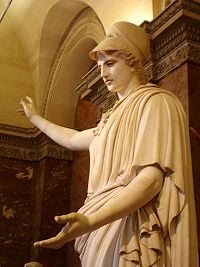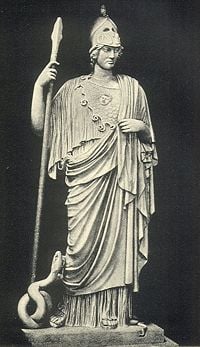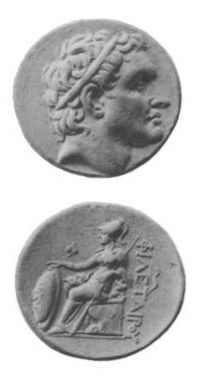Difference between revisions of "Athena" - New World Encyclopedia
Chris Jensen (talk | contribs) |
Chris Jensen (talk | contribs) |
||
| Line 111: | Line 111: | ||
==In classical art== | ==In classical art== | ||
[[Image:AttalusICorrected.jpg|thumb|200px|right|Athena depicted on the obverse side of a [[coin]] of [[Attalus I]]]] | [[Image:AttalusICorrected.jpg|thumb|200px|right|Athena depicted on the obverse side of a [[coin]] of [[Attalus I]]]] | ||
| − | Athena is classically portrayed wearing full armor, with the helmet raised high on the forehead (which reveals her aristocratic yet feminine visage); she carries a spear and a shield with the head of the [[gorgon]] [[Medusa (mythology)|Medusa]] mounted upon it. It is in this standing posture that she was depicted in Phidias's lost gold and ivory statue of her, a towering (12 meter) version of [[Athena Parthenos]] that used to adorn [[Parthenon]]. Athena is also often depicted with an [[owl]] (a symbol of wisdom) sitting on one of her shoulders. In earlier, archaic portraits of Athena in [[Black-figure pottery]], the goddess retains some of her Minoan characteristics, such as enormous bird wings. | + | Athena is classically portrayed wearing full armor, with the helmet raised high on the forehead (which reveals her aristocratic yet feminine visage); she carries a spear and a shield with the head of the [[gorgon]] [[Medusa (mythology)|Medusa]] mounted upon it. It is in this standing posture that she was depicted in Phidias's lost gold and ivory statue of her, a towering (12 meter) version of [[Athena Parthenos]] that used to adorn [[Parthenon]]. Athena is also often depicted with an [[owl]] (a symbol of wisdom) sitting on one of her shoulders. In earlier, archaic portraits of Athena in [[Black-figure pottery]], the goddess retains some of her pre-Hellenic (possibly Minoan) characteristics, such as enormous bird wings. |
Apart from her attributes, there seems to be a relative consensus in sculpture from the fifth century onward as to what Athena looked like. Most noticeable in the face is a high nose with a relatively high bridge that emerges naturally from the forehead. The eyes are typically somewhat deeply set. The lips are usually full but the mouth is fairly narrow, usually just slightly wider than the nose. The neck is slender, graceful and somewhat long. The net result is a serene, somewhat aloof beauty. | Apart from her attributes, there seems to be a relative consensus in sculpture from the fifth century onward as to what Athena looked like. Most noticeable in the face is a high nose with a relatively high bridge that emerges naturally from the forehead. The eyes are typically somewhat deeply set. The lips are usually full but the mouth is fairly narrow, usually just slightly wider than the nose. The neck is slender, graceful and somewhat long. The net result is a serene, somewhat aloof beauty. | ||
==In post-classical culture== | ==In post-classical culture== | ||
| − | + | * Athena (Minerva) is the subject of the $50 1915-S Panama-Pacific commemorative coin. At 2.5 troy oz (78 g) gold, this is the largest (by weight) coin ever produced by the [[United States Mint|U.S. Mint]]. This was the first $50 coin issued by the U.S. Mint and no higher was produced until the production of the $100 platinum coins in 1997. Of course, in terms of face-value in adjusted dollars, the 1915 is the highest denomination ever issued by the U.S. Mint. | |
| − | Athena (Minerva) is the subject of the $50 1915-S Panama-Pacific | + | * For over a century a full-scale replica of the Parthenon has stood in [[Nashville, Tennessee]], which is known as the Athens of the South. In 1990, a gilded [[Athena Parthenos|replica of Phidias' statue]] of the goddess, standing over 12 m tall, was added. |
| − | + | * The state seal of California features an image of Athena (or [[Minerva]]) kneeling next to a brown grizzly bear.[http://www.learncalifornia.org/doc.asp?id=97] | |
| − | For over a century | + | * She is the symbol of the Darmstadt University of Technology, Germany. |
| − | + | * Athena's Helmet is the central feature on the United States Military Academy [http://commons.wikimedia.org/wiki/Image:U.S._Military_Academy_COA.png crest]. | |
| − | The state | + | * Athena is source of influence for feminist theologians such as [[Carol P. Christ]]. |
| − | |||
| − | She is the symbol of the | ||
| − | |||
| − | Athena's Helmet is the central feature on the | ||
| − | |||
| − | Athena is source of influence for feminist theologians such as [[Carol P. Christ]]. | ||
==Notes== | ==Notes== | ||
Revision as of 00:08, 19 May 2007
<find where the "unsourced" tag is coming from>
In Greek mythology, Athena (Greek: Άθηνά, Athēnâ, or Ἀθήνη, Athénē; Latin: Minerva), the shrewd companion of heroes, is a multifaceted Greek goddess whose spheres of influence center around cunning and wisdom. This focus became especially predominant with the rapprochement of Greek philosophy and religion in the later fifth century B.C.E.[1] In addition to her general patronage of wisdom (as exemplified by her support for the cunning intelligence (metis) of such figures as Odysseus), Athena was also associated with more practical aptitudes (techne), including weaving, carpentry, and the disciplined, strategic side of warfare.[2]. Finally, her characterization has a strong ethical component, as she is nearly unique among the Olympians for the fact that few (if any) mythic tales depict her in an amoral or immoral light.[3]
In mythic and artistic representations, she is attended by an owl and is often accompanied by the goddess of victory, Nike. Wearing a goatskin breastplate called the Aegis given to her by her father, Zeus,[4] she is often shown helmeted and with a shield bearing the Gorgon Medusa's head, a votive gift from Perseus. This depiction as an armed warrior likely arose from her assocation with battlefield cunning, which also explains her numerous appearances in Greek mythology as a helper of heroes, including Heracles, Jason, and Odysseus. In classical myth, she never had a consort or lover, and thus was often known as Athena Parthenos ("Athena the virgin"), a name that was enshrined in stone as the Parthenon, on the Acropolis in Athens.
In her role as a protector of cities, Athena was worshiped throughout the Greek world as Athena Polias ("Athena of the city"). However, she was thought to have a special relationship with Athens, as is shown by the etymological connection of the names of the goddess and the city.[5] This ancient relationship is further attested to by an archaic myth where she was described as the mother of Erichthonius (the founder of Athens) following a failed rape attempt (described below).[6]
Name, etymology and origin
In the pre-Hellenic world, it seems likely that Athena was a Minoan (or other non-Mycenaean) deity who achieved early prominence, and was exported around the early Hellenic world, for her role in defending the polis from hostilities.
She had a special relationship with Athens, as is shown by the etymological connection of the names of the goddess and the city.[7] Athena is associated with Athens, a plural name because it was the place where she presided over her sisterhood, the Athenai, in earliest times: "[Mycenae] was the city where the Goddess was called Mykene, and Mycenae is named in the plural for the sisterhood of females who tended her there. At Thebes she was called Thebe, and the city again a plural, Thebae (or Thebes, where the 's' is the plural formation). Similarly, at Athens she was called Athena, and the city Athenae (or Athens, again a plural)."[8] Whether her name is attested in Eteocretan or not will have to wait for decipherment of Linear A.
Athena's name is possibly of Lydian origin.[9] It may be a compound word derived in part from Tyrrhenian "ati", meaning "mother" and the name of the Hurrian Goddess "Hannahannah" shortened in various places to "Ana". In Mycenaean Greek, she possibly appears in a single inscription in the Linear B tablets: A-ta-na-po-ti-ni-ja /Athana potniya/ appears on a text from the Late Minoan II-era "Room of the Chariot Tablets" in Knossos, the earliest Linear B archive anywhere.[10] Though this phrase is often translated as "Mistress Athena", it literally means "the potnia of At(h)ana", which perhaps means "the Lady of Athens";[11] it is uncertain whether there is any connection to the city of Athens.[12] We also find A-ta-no-dju-wa-ja /Athana diwya/, the final part being the Linear B spelling of what we know from ancient Greek as Diwia (Mycenaean di-u-ja or di-wi-ja) "divine" Athena was also a weaver and the god of crafts. (see dyeus).[13]
In his dialogue Cratylus, Plato gives the etymology of Athena's name based on the view of the ancient Athenians,[14] from A-theo-noa (A-θεο-νόα) or E-theo-noa (H-θεο-νόα) meaning "the mind of God" (Cratylus 407b). Plato Her name is derived from Greek Ἀθεονόα, Atheonóa— which the Greeks rationalised as from god's (theos) mind (nous).
Herodotus noted that the Egyptian citizens of Sais in Egypt worshipped a goddess whose Egyptian name was Neith;[15] they identified her with Athena. (Timaeus 21e), (Histories 2:170-175).
Some authors believe that in early times, Athena was an owl herself, or a bird goddess in general: in Book 3 of the Odyssey, she takes the form of a sea-eagle. In the development of her iconography, starting from archaic vase-paintings, she dropped her prophylactic owl-mask before she lost her wings. "Athene, by the time she appears in art," Jane Ellen Harrison remarked, "has completely shed her animal form, has reduced the shapes she once wore of snake and bird to attributes, but occasionally in black-figure vase-paintings she still appears with wings."[16] Some authors[attribution needed] claim her tasseled aegis may be the remnants of wings.
Mythology
Birth of Athena, daughter of Zeus
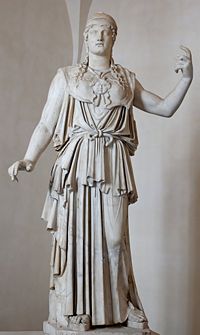
Athena is most commonly described as the daughter of Zeus. It is also often implied[citation needed] that she is his first-born child, which accords her special status: the weapons for which she is so famous are weapons she and he share exclusively, including the thunderbolt.
The Olympian version
In the Olympian pantheon, Athena was remade as the favorite daughter of Zeus, born fully armed from his forehead after he swallowed her mother, Metis.[17] The story of her birth comes in several versions. In the one most commonly cited, Zeus lay with Metis, the goddess of crafty thought and wisdom, but immediately feared the consequences. It had been prophesied that Metis would bear children more powerful than the sire,[18] even Zeus himself. In order to forestall these dire consequences, after lying with her, Zeus "put her away inside his own belly;" he "swallowed her down of a sudden,>"[19] He was too late: Metis had already conceived a child. When it came time, Zeus was in great pain; Prometheus, Hephaestus, Hermes or Palaemon (depending on the sources examined) cleaved Zeus's head with the double-headed Minoan axe (the labrys of the Great Goddess). Athena leaped from Zeus's head, fully grown and armed with a shout, "and pealed to the broad sky her clarion cry of war. And Ouranos trembled to hear, and Mother Gaia" {Pindar, Seventh Olympian Ode).
Hera was so annoyed at Zeus producing a child apparently on his own that she caused herself to conceive and bear Hephaestus by herself. Metis never bore any more children, and Zeus persisted as supreme ruler of Mount Olympus.
Other origin tales
Fragments attributed by the Christian Eusebius of Caesarea to the semi-legendary Phoenician historian Sanchuniathon, which Eusebius thought had been written before the Trojan war, make Athena instead the daughter of Cronus, a king of Byblos who is said to have visited 'the inhabitable world' and bequeathed Attica to Athena.
Pallas Athena
The major competing tradition regarding Athena's parentage involves some of her more mysterious epithets: Pallas, as in Ancient Greek Παλλάς Άθήνη (also Pallantias) and Tritogeneia (also Trito, Tritonis, Tritoneia, Tritogenes). A separate entity named Pallas is invoked – as one or more of Athena's father, sister, foster-sister, or opponent in battle. In every case, Athena kills Pallas and thereby gains the name for herself.
When Pallas is Athena's father the events, including her birth, are located near a body of water named Triton or Tritonis. When Pallas is Athena's sister or foster-sister, Athena's father or foster-father is himself Triton, the son and herald of Poseidon. But Athena may be called the daughter of Poseidon and a nymph named Tritonis without involving Pallas. Likewise, Pallas may be Athena's father or opponent without involving Triton. [20][21] [22] On this topic, Walter Burkert says "she is the Pallas of Athens, Pallas Athenaie, just as Hera of Argos is Here Argeie.[23] For the Athenians, Burkert notes, Athena was simply "the Goddess", he theos, certainly an ancient title.
Athena Parthenos: Virgin Athena
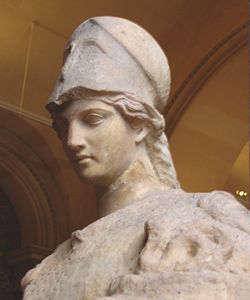
Athena never had a consort or lover, and thus was also known as Athena Parthenos, "Virgin Athena." Her most famous temple, the Parthenon, on the Acropolis in Athens takes its name from this title. It was not merely an observation of her virginity, but a recognition of her role as enforcer of rules of sexual modesty and ritual mystery. This role is expressed in a number of stories about Athena.
Erichthonius
Hephaestus attempted to rape Athena but she eluded him. His semen fell on the ground, and Erichthonius was born from the Earth, Gaia. Athena then raised the baby as a foster mother.[24]
Athena put the infant Erichthonius in a small box which she entrusted to the care of three sisters, Herse, Pandrosus and Aglaulus, then princesses of Athens. The goddess didn't tell them what the box contained, but warned them not to open it till she returned. One or two sisters opened the cista to reveal Erichthonius, in the form (or embrace) of a serpent. The serpent, or insanity induced by the sight, drives Herse and Pandrosus to threw themselves off the Acropolis.[25]
Jane Harrison (Prolegomena) finds this to be a simple cautionary tale directed at young girls carrying the cista in the Thesmophoria rituals, to discourage them from opening it outside the proper context.
Erichthonius later became King of Athens and implemented many beneficial changes to Athenian culture. During this time, Athena frequently protected him.
There is another version of the myth of the Athenian princesses, told in Ovid's Metamorphoses in which Hermes falls in love with Herse. Herse, Aglaulus and Pandrosus go to the temple to offer sacrifices to Athena. Hermes demands help from Aglaulusto seduce Herse. Aglaulus demands money in exchange. Hermes gives her the money the sisters had already offered to Athena.
As punishment for Aglaulus's greed, Athena asks the goddess Envy to make Aglaulus jealous of Herse. When Hermes arrives to seduce Herse, Aglaulus stands in his way instead of helping him as she had agreed. He turns her to stone.[26]
Medusa and Tiresias
Medusa, unlike her two sister-Gorgons, was mortal and extremely beautiful. But she had sex with — or was raped by — Poseidon in a temple of Athena. Upon discovering the desecration of her temple, Athena changed Medusa's form to match that of her sister Gorgons as punishment. Medusa's hair turned into snakes, her lower body was transformed, and meeting her gaze would turn any living creature to stone.
In one version of the Tiresias myth, Tiresias stumbled upon Athena bathing, and was blinded by her nakedness.[27] To compensate him for his loss, she sent serpents to lick his ears, which gave him the gift of prophecy.
Lady of Athens
Athena competed with Poseidon to be the patron deity of Athens, which was yet unnamed in this telling. They agreed that each would give the Athenians one gift and that the Athenians would choose the gift they preferred. Poseidon struck the ground with his trident and a spring sprang up; this gave them a means of trade and water, but it was salty and not very good for drinking. (In an alternate version, Poseidon offered the first horse.) Athena, however, offered them the first domesticated olive tree. The Athenians (or their king, Cecrops) accepted the olive tree and along with it Athena as their patron, for the olive tree brought wood, oil and food. This is thought[attribution needed] to commemorate a clash between the inhabitants during Mycenaean times and newer immigrants. It is interesting to note that Athens at its height was a significant sea power, defeating the Persian fleet at the Battle of Salamis near Salamis Island in 480 B.C.E. Athena was also the patron goddess of several other cities, notably Sparta.
Counselor
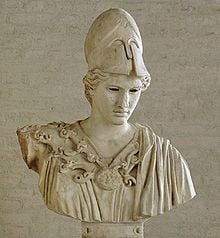
Athena guided Perseus in his quest to behead Medusa. She instructed Heracles to skin the Nemean Lion by using its own claws to cut through its thick hide. She also helped Heracles to defeat the Stymphalian Birds, and to navigate the underworld so as to capture Cerberos.
Odysseus' cunning and shrewd nature quickly won Athena's favor, though she is largely confined to aiding him only from afar (implanting thoughts in his head) during his journey home from Troy. It is not until he washes up on the shore of an island where Nausicaa is washing her clothes that Athena can actually arrive herself to provide more tangible assistance. She appears in Nausicaa's dreams to ensure the princess rescues Odysseus and eventually sends him to Ithaca. Athena, herself, appears in disguise to Odysseus upon his arrival. She initially lies and tells him Penelope, his wife, has remarried and Odysseus is believed to be dead, though Odysseus lies to her, seeing through her disguise. Pleased with his resolve and shrewdness, she reveals herself to him and tells him everything he needed to know in order to win back his kingdom. She disguises him as an elderly man so that he will not be noticed by the Suitors or Penelope and she helps Odysseus defeat his suitors and end the feud against their relatives.
Arachne
The fable of Arachne is a late addition to Greek mythology,[28] that does not appear in the myth repertory of the Attic vase-painters. Arachne's name simply means "spider" (αράχνη). Arachne was the daughter of a famous dyer in Tyrian purple in Hypaipa of Lydia. She became so conceited of her skill as a weaver that she began claiming that her skill was greater than that of Athena herself.
Athena gave Arachne a chance to redeem herself by assuming the form of an old woman and warning Arachne not to offend the gods. Arachne scoffed and wished for a weaving contest, so she could prove her skill.
Athena wove the scene of her victory over Poseidon that had inspired her patronage of Athens. According to the Latin narrative, Arachne's tapestry featured twenty-one episodes of the infidelity of the gods: Jupiter being unfaithful with Leda, with Europa, with Danae.
Even Athena admitted that Arachne's work was flawless, but was outraged at Arachne's disrespectful choice of subjects that displayed the failings and transgressions of the gods.[29] Finally losing her temper, Athena destroyed Arachne's tapestry and loom, striking it with her shuttle, Arachne realized her folly and hanged herself.
In Ovid's telling, Athena took pity on Arachne who was changed into a spider. The story suggests that the origin of weaving lay in imitation of spiders and that it was considered to have been perfected first in Asia Minor.
Cult and attributes
Her epithets included Άτρυτώνη, Atrytone (= the unwearying), Παρθένος, Parthénos (= virgin), and Ή Πρόμαχος, Promachos (the pre-fighter/-tress, i. e. the person who fights in front).
In poetry from Homer onward, Athena's most common epithet is glaukopis (γλαυκώπις), which is usually translated "bright-eyed" or "with gleaming eyes".[30] It is a combination of glaukos (γλαύκος, meaning "gleaming," "silvery," and later, "bluish-green" or "gray") and ops (ώψ, "eye," or sometimes, "face"). It is interesting to note that glaux (γλαύξ, "owl") is from the same root, presumably because of its own distinctive eyes. The bird which sees in the night is closely associated with the goddess of wisdom: in archaic images, she is frequently depicted with an owl perched on her head. In earlier times, Athena may well have been a bird goddess, similar to the unknown goddess depicted with owls, wings and bird talons on the Burney relief, a Mesopotamian terracotta relief of the early second millennium B.C.E.
In the Iliad (4.514), the Homeric Hymns and in Hesiod's Theogony, she is given the curious epithet Tritogeneia. The meaning of this term is unclear. It seems to mean "Triton-born," perhaps indicating that the sea-god was her father according to some early myths,[31] or, less likely, that she was born near Lake Triton in Africa. Another possible meaning is "triple-born" or "third-born," which may refer to her status as the third daughter of Zeus or the fact she was born from Metis, Zeus and herself; various legends list her as being the first child after Artemis and Apollo, though other legends identify her as Zeus' first child.
In her role as judge at Orestes' trial on the murder of his mother, Clytemnestra (which he won), Athena won the epithet Athena Areia.
Athena was later associated with the application of philosophy to cult in the fifth century. She remained the patroness of weaving, crafts and the more disciplined side of war[32]. Athena's wisdom encompasses the technical knowledge employed in weaving, metal-working, but also includes the cunning intelligence (metis) of such figures as Odysseus.
The owl and the olive tree are sacred to her. She is attended by an owl, and is often accompanied by the goddess of victory, Nike. Wearing a goatskin breastplate called the Aegis given to her by her father, Zeus,[33], she is often shown helmeted and with a shield bearing the Gorgon Medusa's head, a votive gift of Perseus. Athena is an armed warrior goddess, and appears in Greek mythology as the counselor of many heroes, including Heracles, Jason, and Odysseus.
Athena was given many other cult titles. She had the epithet Athena Ergane as the patron of craftsmen and artisans. With the epithet Athena Parthenos ("virgin"), Athena was worshiped on the Acropolis, especially in the festival of the Panathenaea. With the epithet Athena Promachos she led in battle. With the epithet Athena Polias ("of the city"), Athena was the protectress of Athens and its Acropolis, but also of many other cities, including Argos, Sparta, Gortyn, Lindos, and Larisa. She was given the epithet Athena Hippeia or Athena Hippia as the inventor of the chariot, and was worshipped under this title at Athens, Tegea and Olympia. As Athena Hippeia she was given an alternative parentage: Poseidon and Polyphe, daughter of Oceanus. [34][35]. In each of these cities her temple was frequently the major temple on the acropolis.[36] Athena was often equated with Aphaea, a local goddess of the island of Aegina, located near Athens, once Aegina was under Athenian's power.
In classical art
Athena is classically portrayed wearing full armor, with the helmet raised high on the forehead (which reveals her aristocratic yet feminine visage); she carries a spear and a shield with the head of the gorgon Medusa mounted upon it. It is in this standing posture that she was depicted in Phidias's lost gold and ivory statue of her, a towering (12 meter) version of Athena Parthenos that used to adorn Parthenon. Athena is also often depicted with an owl (a symbol of wisdom) sitting on one of her shoulders. In earlier, archaic portraits of Athena in Black-figure pottery, the goddess retains some of her pre-Hellenic (possibly Minoan) characteristics, such as enormous bird wings.
Apart from her attributes, there seems to be a relative consensus in sculpture from the fifth century onward as to what Athena looked like. Most noticeable in the face is a high nose with a relatively high bridge that emerges naturally from the forehead. The eyes are typically somewhat deeply set. The lips are usually full but the mouth is fairly narrow, usually just slightly wider than the nose. The neck is slender, graceful and somewhat long. The net result is a serene, somewhat aloof beauty.
In post-classical culture
- Athena (Minerva) is the subject of the $50 1915-S Panama-Pacific commemorative coin. At 2.5 troy oz (78 g) gold, this is the largest (by weight) coin ever produced by the U.S. Mint. This was the first $50 coin issued by the U.S. Mint and no higher was produced until the production of the $100 platinum coins in 1997. Of course, in terms of face-value in adjusted dollars, the 1915 is the highest denomination ever issued by the U.S. Mint.
- For over a century a full-scale replica of the Parthenon has stood in Nashville, Tennessee, which is known as the Athens of the South. In 1990, a gilded replica of Phidias' statue of the goddess, standing over 12 m tall, was added.
- The state seal of California features an image of Athena (or Minerva) kneeling next to a brown grizzly bear.[3]
- She is the symbol of the Darmstadt University of Technology, Germany.
- Athena's Helmet is the central feature on the United States Military Academy crest.
- Athena is source of influence for feminist theologians such as Carol P. Christ.
Notes
- ↑ Chapter VII ("Philosophical Religion") in Walter Burkert's magisterial Greek Religion (1985) treats these transformations in some detail.
- ↑ This final points marks her distinction from Ares, who was associated with madness, violence and bloodlust.
- ↑ Rose, 108.
- ↑ The Sky God's association with this artifact is attested to by the fact that he is also, on occasion, described as "Aegis-bearing Zeus." Theoi.com has a list of the various mythic texts that use this moniker to describe Zeus.
- ↑ "Whether the goddess was named after the city or the city after the goddess is an ancient dispute." Burkert, 139.
- ↑ Pseudo-Apollodorus, Bibliotheke 3.14.6.
- ↑ "Whether the goddess was named after the city or the city after the goddess is an ancient dispute" (Burkert, p. 139).
- ↑ Ruck and Staples, 24.
- ↑ G. Neumann, "Der lydische Name der Athena. Neulesung der lydischen Inschrift Nr. 40" [The Lydian name of Athena. New reading of the Lydian inscription No. 40]. Kadmos 6 (1967), 80-87.
- ↑ Kn V 52 (text 208 in Ventris and Chadwick).
- ↑ Palaima, p. 444.
- ↑ Burkert, p. 44.
- ↑ Ventris and Chadwick [page missing]
- ↑ "That is a graver matter, and there, my friend, the modern interpreters of Homer may, I think, assist in explaining the view of the ancients. For most of these in their explanations of the poet, assert that he meant by Athene "mind" (nous) and "intelligence" (dianoia), and the maker of names appears to have had a singular notion about her; and indeed calls her by a still higher title, "divine intelligence" (Thou noesis), as though he would say: This is she who has the mind better than others. Nor shall we be far wrong in supposing that the author of it wished to identify this Goddess with moral intelligence (en ethei noesin), and therefore gave her the name ethonoe; which, however, either he or his successors have altered into what they thought a nicer form, and called her Athene". (Cratylus 407b).
- ↑ "The citizens have a deity for their foundress; she is called in the Egyptian tongue Neith, and is asserted by them to be the same whom the Hellenes call Athene; they are great lovers of the Athenians, and say that they are in some way related to them". ( Timaeus 21e)
- ↑ Harrison 1922:306. (Harrison 1922:307 fig. 84: detail of a cup in the Faina collection).
- ↑ Harrison's famous characterisation of this myth-element as "a desperate theological expedient to rid an earth-born Kore of her matriarchal conditions" has never been refuted (Harrison 1922:302).
- ↑ Compare the prophecy concerning Thetis.
- ↑ Hesiod, Theogony 890ff and 924ff.
- ↑ Graves, Robert, The Greek Myths I, "The Birth of Athena," 8.a.
- ↑ Graves, p. 51.
- ↑ The story comes from Libyan (modern Berbers) where the Greek Athena and the Egyptian Neith blend in to one god. The story is not so often referenced because some facts contradict other more well documented facts. Frazer, vol. 2 p.41
- ↑ Burkert, p. 139.
- ↑ Pseudo-Apollodorus, Bibliotheke 3.14.6.
- ↑ Graves, Robert, The Greek Myths I, "The Nature and Deeds of Athena" 25.d.
- ↑ Ovid, Metamorphoses, X. Aglaura, Book II, 708-751; XI. The Envy, Book II, 752-832.
- ↑ Graves, Robert, The Greek Myths I,"The Nature and Deeds of Athena" 25.g.
- ↑ The tale is recorded in Ovid's Metamorphoses ( (vi.5-54 and 129-145) and mentioned in Virgil's Georgics, iv, 246.
- ↑ This takes for granted a late, moralizing view of Greek myth.
- ↑ Henry George Liddell, Robert Scott, 1940, A Greek-English Lexicon, ISBN 0-19-864226-1, online version at the Perseus Project
- ↑ Karl Kerenyi suggests that "Tritogeneia did not mean that she came into the world on any particular river or lake, but that she was born of the water itself; for the name Triton seems to be associated with water generally." (Kerenyi, p. 128).
- ↑ Violence and bloodlust were Ares' domain.
- ↑ Zeus is also "Aegis-bearing Zeus".
- ↑ [1]
- ↑ [2]
- ↑ Burkert, p. 140.
Bibliography
- Burkert, Walter, 1985. Greek Religion (Harvard).
- Graves, Robert, (1955) 1960. The Greek Myths revised edition.
- Harrison, Jane Ellen, 1903. Prolegomena to the Study of Greek Religion.
- Kerenyi, Karl, 1951. The Gods of the Greeks (Thames and Hudson).
- Palaima, Thomas, 2004. "Appendix One: Linear B Sources." In Trzaskoma, Stephen, et al., eds., Anthology of Classical Myth: Primary Sources in Translation (Hackett).
- Ruck, Carl A.P. and Danny Staples, 1994. The World of Classical Myth: Gods and Goddesses, Heroines and Heroes (Durham, NC).
- Telenius, Seppo Sakari, 2005 and 2006. Athena-Artemis.
- Ventris, Michael and John Chadwick, 1973. Documents in Mycenaean Greek (Cambridge).
See also
External links
- (Carlos Parada) Athena Album Repertory of main Athena types and post-Renaissance depictions (accessed May 18, 2007).
- Roy George, "Athena: The sculptures of the goddess": Another, more extensive repertory of Greek and Roman types (accessed May 18, 2007).
- Theoi.com Cult of Athena Extracts of classical texts (accessed May 18, 2007).
- The Nashville Parthenon - Overview of the American replica of the Parthenon (accessed May 18, 2007).
Credits
New World Encyclopedia writers and editors rewrote and completed the Wikipedia article in accordance with New World Encyclopedia standards. This article abides by terms of the Creative Commons CC-by-sa 3.0 License (CC-by-sa), which may be used and disseminated with proper attribution. Credit is due under the terms of this license that can reference both the New World Encyclopedia contributors and the selfless volunteer contributors of the Wikimedia Foundation. To cite this article click here for a list of acceptable citing formats.The history of earlier contributions by wikipedians is accessible to researchers here:
The history of this article since it was imported to New World Encyclopedia:
Note: Some restrictions may apply to use of individual images which are separately licensed.
